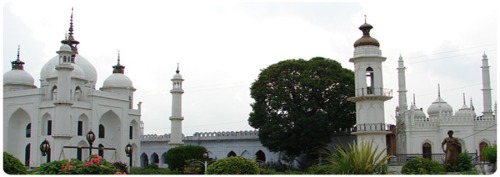
Lucknow city is popularly known as the 'the city of Nawabs'. Situated on the banks of the river Gomti, it dates back to the time of the Suryavanshi dynasty. Lucknow, the capital of Uttar Pradesh, was founded by Nawab Asaf-ud-Daula. In the olden times, it served as the capital of the nawabs of Awadh and it is one of the reasons why it is also called as the city of the Nawabs. The era of the Nawabs bestowed Lucknow with the courteous culture as well as mouthwatering delicacies for which it is famous today. Travel to Lucknow with us to find more information on this interesting city!Even after witnessing tremendous modernization, Lucknow has managed to retain its age-old charm and glory. The warmth, the hospitality and the formality of the city have still not been lost. The era of the nawabs also gifted Lucknow with the literature, music, dance and arts and crafts that draw tourists here. Infact, it was in the streets of the city only that Tabla and Sitar were born. Lucknow tourism brings one closer to the glorious days city, through a visit to its numerous monuments and ruins The city of Lucknow has a magical charm surrounding it. Be it its delicious cuisine or its heart melting culture, the city leaves an everlasting impression on its visitors. It is one of the few places where one can still find people saying 'aap', 'janab', 'pehle aap', etc. Even though flats have replaces Nawabi mansions, the city is still as charismatic as before. So, visit Lucknow and lose yourself in the magic and allure of the city. Lucknow – The upcoming METRO is a hallmark of cultural extravaganza, known all over the world for its many splendours. A city that has a magical charm, a charm that's forever and a charm that's apart. Be it the cultural charm or the monumental one, all are well conserved here to make Lucknow " The city of many splendours". Walking through the lanes and by-lanes of Chowk and Aminabad one finds Lucknow of yore. The 'tehzib' or mannerism is still prominent and a topic of great appreciation. This is a city that still speaks the language of "aap-janab""pehle aap" is still a part of everyday life for a true Lakhnawi. – and so natural it is – Aadab or salutation which has its own sophistication and style. Dress forms though have changed noticeably in the span of a century, yet the beauty and charisma of Chikan – the intricate and delicate hand embroidery, still rules the wardrobe. Lucknow is in fact among a few cities that duly understands the grace of the 'dupattas' or the covering cloth. Wisdom, women and wine are the three things truly understood and respected by the Nawabs. Not a thing of condemnation but an institution it was the "kothas", where sons of Nawabs were deliberately sent to learn the culture, sophistication and respect for the fairer sex. Muzzafar Ali's unforgettable film "Umrao Jaan" is a depiction of this social institution. Love was found in either Paris or Lucknow– a proof of this is the lovers lane in the posh modern Hazratganj: these lanes were used as a meeting place for the lonely hearts to escape the monitoring eyes of their parents. "Kan kauwe bazi" or kite flying was not only a pastime but the means of sending love letters to the beloved, "kal shaam kothe pe aana, hum intezaar kareinge tumhara"– Tomorrow in the evening come to the terrace, I'll wait for you. Such words were written on the patang or the kite and the kite was flown and dropped on the beloved's terrace. A story goes that once a Chhote Nawab did this with his beloved and instead of the beloved getting the letter her mother found it and the love bug bit her, assuming that the Bade Nawab has done this sweet and naughty thing, she reciprocated in the same manner writing "Intezaar tumhara hi to tha humein, umra bhar rahein takte rahe, der lagee aane mein tumko, shukr hai phir bhi aaye to"– I was waiting for this all my life, you came late yet now you have come. Thus started the love between the Bade Nawab and the Badi Begum which ended up in their marriage and left the real ones to repent. Today in Lucknow many things may have impurities but preparations like those of Tunde-ke-kabab, Rahim-ke-kulche nihari, Kababs at Akbari Gate, Ram Asrey ki malai aur lal peda, Raja-ki-thandai, Parathas naans aur sheermals ya Sharma-ki-chaat have held their heads high due to purity and standards maintained. Good eateries in Lucknow are often found in the serpentine lanes of old Lucknow. So many of you would have been born in Lucknow like me, but will agree that each day is distinct. The shades of the monuments differ with each sun and moon. You discover and rediscover Lucknow everyday. No one has known Lucknow to the full and will never. That is why : "Jisey Aap Kehte Hain Lucknow – Usey Hum Kehte Hain Duja Jahan" (The place that you call Lucknow – we call the other world) .
Chota Imambara
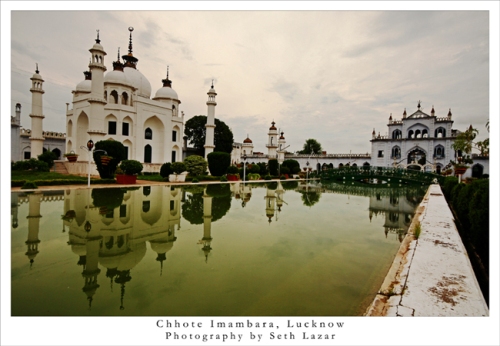
Chota Imambara is the landmark of Lucknow. This monument is also known as Husseinabad Imambara in Lucknow as this place was the office of the erstwhile Husseinabad trust that owned the city once. Chota Imambara is an imposing monument located in the Old City area of Lucknow close to Chowk.
The story of Imambara is no less interesting than the Imambara itself. It happened once in early 19th century that a persistent famine engulfed Oudh. That famine broke the backs of lower strata and agriculture labors. The then Nawab of Awadh named Muhammad Ali Shah commissioned Chota Imambara under 'Food for Work' program initiated to bring respite for the city populace. The monument that was erected in order to serve as the mausoleum for Muhammad Ali Shah got completed in the year 1837. Chota Imambara is also sometimes referred as 'The Palace of Light' in British History Chronicles because its decorations during festive season.
Christ Church
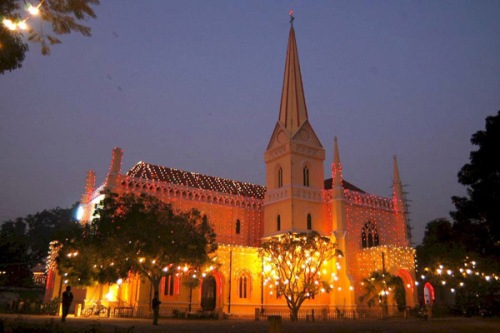
Christ Church, designed by General Hutchinson, is situated near Wingfield Park in Lucknow. It was built in memory of those who died in the revolt of 1857. The church was renovated in 1904. It houses some fine memorial tablets and brass collections.
The University of Lucknow
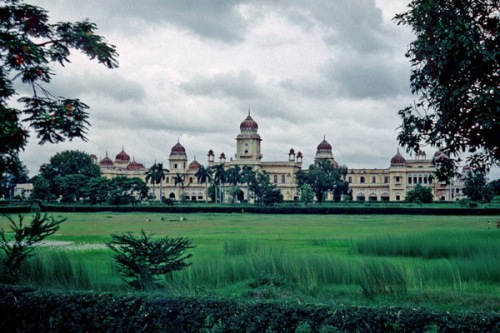
University of Lucknow
The University of Lucknow grew out of the prestigious Canning College, Lucknow, founded in 1867 by Raja Dakshinaranjan Mukherjee, also grew out of King George's Medical College and Isabella Thoburn College.
Lucknow University was set up as a result of the far-reaching recommendations of the Sadler Commission which had been set up originally in 1917 to just investigate the ""conditions and prospects of the University of Calcutta". The Honorable Raja Sir Muhammad Ali Mohammad Khan of Mahmudabad made a strong plea in the Pioneer for the creation of a separate University at Lucknow which was reinforced by all the Taluqdars of Awadh. Sir Harcourt Butler, the then Lt. Governor of United Provinces also gave active support to the idea.
Lucknow University was established in law by the Governor General on November 25, 1920, Sir Harcourt Butler laid the foundation stone of the University on March 19, 1921, and Dr. Gyanendra Nath Chakravarti became its first vice-chancellor. On July 17, 1921 teaching classes commenced.
The Taj Residency, Lucknow
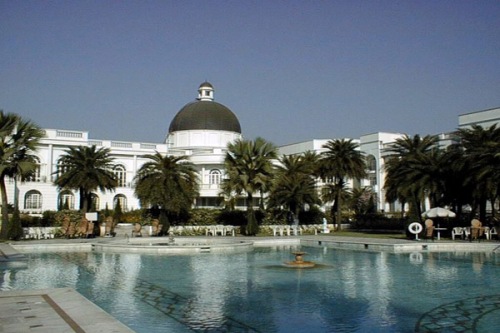
The Taj Residency, Lucknow (Uttar Pradesh, India) set amidst 33 acres of landscaped gardens, reflects the glory of the Nawabi era through its architecture and décor. The hotel is located 4 km from the city centre.
Accommodation : 110 centrally air-conditioned rooms including 4 suites.
Standard: Guests can choose from elegantly appointed Garden Facing or Pool Facing rooms (some having a balcony) that offer guest amenities like international direct dial facility, mini bar, complimentary tea/coffee maker, channel music and colour television
with satellite programmes. Interconnecting rooms, ideal for families, also available.
Executive: Located at the lobby level, all rooms face the swimming pool. Furnishings include a touch of traditional Awadhi chikaan embroidery, colourful place rugs and artefacts.
Deluxe: These rooms are large rooms on the ground floor with a separate sitting area and a poolside view.
Executive Suites: Elegantly appointed, pool facing and garden facing two-room units. These suites are well-planned with a compact living area, a bedroom and bathroom.
Distance : Agra : 360 kms, Kanpur : 80 kms, Allahabad : 228 kms, Varanasi – 300 kms
Lucknow Ashram – Hanuman Sethu Mandir
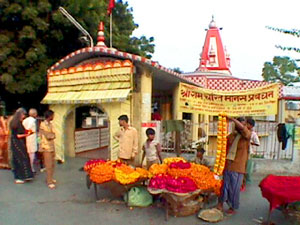
Hanuman Setu Mandir infront of LU
Inaugurated in January 1966. This ashram includes 2 Neem Karoli Baba murtis, 2 Hanuman murtis, and 2 Shiva Linga. This temple performs a major service in distributing Maharaj-ji's prasad in Lucknow, and seems to be one of the most visited temples in the city. The ashram is always decorated as for a bhandara, thanks to a devoted staff. Maharaj-ji said that Lucknow Sankat Mochan Hanuman-ji (known as "the wish fulfilling Hanuman") is "the Governor General of all Hanuman's." Wall murals depict: Ram and Sita, and Ram and Laxshman with Hanuman and the army of monkeys and bears building the bridge to Lanka. A Mahasamadhi Bhandara is held here shortly after the mahasamadhi bhandara in Kanpur. A very limited number of westerners are occasionally accommodated at this ashram.
Address
Shree Sankat Mochan Hanuman Temple
Hanuman Setu,
University Road,
Lucknow-226007.
Lal Bahadur Shastri Institute of Management & Development Studies
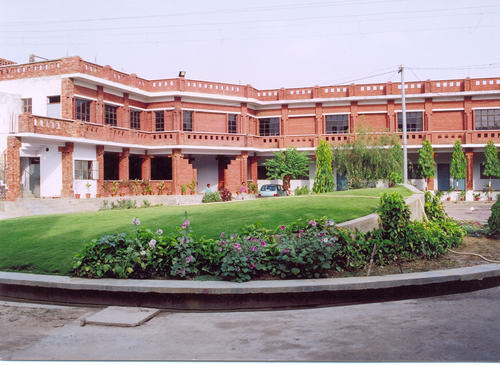
Lal Bahadur Shastri Institute of Management & Development Studies is an autonomous non-profit body registered in the year 1982 under the SOCIETIES REGISTRATION ACT 1860. The primary objective of the institute is to serve the industrial sector of the country in various fields of management & Information Technology. The goal of the institute is to impart training in the software development, managerial fields in order to enable them to bear higher responsibilities in the Public and Private sector undertaking, by way of providing continuing educational facilities, in-house software development, holding conferences, meeting, discussions, seminars and encouraging reading of papers on professional Advancement/Development.
Famous In Lucknow
| aalu ki tikkiyan | : potato cutlets |
| adde-baaz | : regular |
| arvi ka salan | : colocasia curry |
| balai | : thick layer of fresh cream |
| bawarchi | : cook |
| bawarchi tola | : cooks' quarters (in a town) |
| biryani | : highly seasoned rice cooked with meat, fish, egg, or vegetables |
| chaat | : spicy vegetarian snack |
| murg-mussallam | : whole chicken carefully spiced and slowly cooked |
| mutanjan | : sweetish mutton biryani |
| namash | : souffle-like mildly sweet and fluffy creamy delight |
| nehari | : beef/lamb trotters braised and then stewed overnight, further prepared in the morning and eaten with kulchas for breakfast |
| nehari khaas | : special nehari |
| os ki rani | : "queen of dews" |
| chaatwala | : chaat seller |
| chandi qalia | : mutton curry in gravy mixed/topped with crushed edible silver leaves |
| daawat | : feast |
| paan | : betel leaf with areca nut/other fillings/ spices, chewed as a delicacy |
| patili kabab | : mincemeat kabab made in deep copper/brass vessel |
| dalmoth | : savoury mixture |
| puri | : deep-fried puffy bread |
| desi desavari | : a particular betel leaf |
| parind puri | : puri stuffed with a small live bird |
| dudhiya barfi | : white, wet and firm milk sweet |
| galawat ke kabab | : kababs made from very finely ground, tenderized meat |
| gilafi kulcha | : very soft leavened bread |
| gol gappa | : puffed wafer, eaten with a spicy filling, in one mouthful |
| halwa sohan | : special sweet made with cereals, ghee, sugar, garnished with dried fruit |
| halwai | : sweet-maker, seller |
| imarti | : deep-fried ring of urad dal with a little wheat flour added, dipped in sugar syrup; more regular and elaborately shaped than a jalebi |
| jalebi | : syrup-filled deep-fried ring of flour |
| kabravali kacchori | : deep-fried bread with filling made and sold at a shop by a grave in Aminabad |
| kaccha keema | : uncooked mince |
| khaat | : divan/stringed bed |
| korma | : mildly spiced dish of meat marinaded in yoghurt |
| kulcha | : leavened bread |
| kulfi | : milk thickened, mixed with saffron, pistachios, etc and frozen into ice-cream |
| pista-badam ki khichri | : pistachio-almond rice preparation |
| rabri | : semi-liquid thickened milk sweet preparation |
| redhi | : hand-drawn cart |
| samosa | : deep-fried potato/peas/meat-filled triangles of flour |
| seviyon ka muzaffar | : sweet vermicelli, fried and soaked in sugar syrup, with milk added; scatters when thrown on a plate |
| shab degh | : a beautiful blend of whole turnips, mutton balls (koftas), and spices cooked in a deep pan overnight |
| shabnam | : morning dew |
| shahi galawat | : "royal" papaya paste to tenderize meat |
| shami kabab | : spherical mincemeat kabab |
| sheermal | : invented in Lucknow, a rich flat bread made of flour, milk, fat, and saffron |
| thandai | : cooling spiced milk beverage |
| thela | : cart |
| tikki | : cutlet |
| kundan qalia | : mutton curry in gravy mixed/topped with crushed edible gold leaves |
| Lakhnawi | : language spoken in Lucknow/of Lucknow |
| tunde ke kabab / tunde ke shahi galawat ke kabab | : kababs, made from very finely ground, delicately marinaded, tenderized meat |
| waraqui paratha | : "layered" unleavened fried bread |
| lal peda | : milk thickened into chewy, flat, round sweets |
| lassi | : chilled frothed yoghurt drink |
| zaiqa | : taste/flavour |
| zarda pulao | : sweet yellow rice coloured and flavoured with saffron |
| Mahoba paan patta | : tender/crisp betel leaves from the Mahoba district of Uttar Pradesh |
| malai paan | : triangular leaves of cream (paanshaped) with a sweet filling |
Gomti River
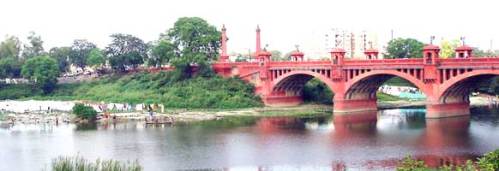
The Gomti originates from Fulhar Lake, near Madho Tanda, Pilibhit, India. It extends 900 km (560 miles) through Uttar Pradesh and meets the Ganges River near Saidpur in Ghazipur.
The river is a thin stream until it reaches Mohamadi (about 100 km from its origin) where it is joined by a prominent tributary called the Sarayu River. From here the river is well defined. Another major tributary is the Sai River, which joins near Jaunpur.
After 240 km the Gomti enters Lucknow, through which it meanders for about 12 km. At the entrance point water is lifted from the river for the city's water supply. 25 city drains in the Lucknow area drain untreated sewage into the Gomti. At the downstream end the Gomti barrage impounds the river converting it into a lake.
The cities of Lucknow, Lakhimpur Kheri, Sultanpur and Jaunpur are located on the banks of the Gomti and are the most prominent of the 15 towns located in its catchment area. The river cuts the Jaunpur city into two equal half and becomes wider in Jaunpur.
The Gomti River originates from the east of Pilibhit town at a height of 200 meters. The river is also known by the names as Gumti or Gomati. The Gomti River is a tributary of the Ganges River. The river drains the area between river Ramganga and Sharda. After flowing through the districts of Lucknow, Barabhanki, Sultanpur, Faizabad and Jaunpur, it joins with River Ganga. On the banks of the river are located the cities of Lucknow, Sultanpur and Jaunpur.
The river originates near the Maldo Tada town of Pilibhit. The river extends to about 900 km. The river appears to be a thin stream till it reaches Mohamadi. It is from here onwards it takes the shape of a river. From here it is joined by another prominent tributary called Sarayan. The other major tributary is the Sai River. Then it reaches the Lucknow city and meanders through the city.
According to the Hindu Mythology, the river is the daughter of Sage Vashistha and it is believed that bathing in the rivers would wash away ones sins
La Martiniere Lucknow
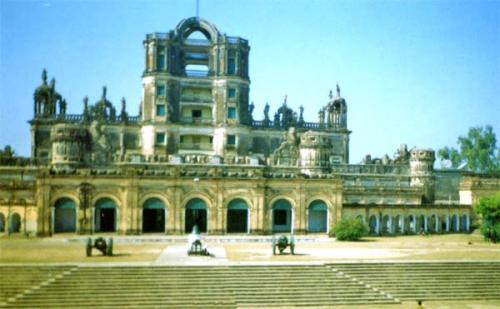
La Martinière College is a premiere educational institution located in Lucknow, the capital of the Indian State of Uttar Pradesh. The College consists of two schools on different campuses for boys and girls. La Martinière Boys' College was founded in 1845 and La Martinière Girls' College was established in 1869. The Boys' College is the only school in the world to have been awarded royal battle honours[1] for its role in the defence of Lucknow during the mutiny of 1857. The two Lucknow colleges are part of the La Martinière family of schools founded by the French adventurer Major General Claude Martin. There are two La Martinière Colleges in Kolkata and three in Lyon. La Martinière provides a liberal education and the medium of instruction is the English language. The schools cater for pupils from the ages of five through to 17 or 18, and are open to children of all religious denominations. The schools have both day scholars and boarders.
City Montessori School (CMS) Lucknow
The City Montessori School (CMS) Lucknow, India, was founded in 1959 by a young visionary couple, Mr. Jagdish Gandhi, a socially motivated Gandhian, along with his wife Dr. (Mrs.) Bharti Gandhi, M.Ed., Child Psychologist. Rich in enthusiasm, the devoted pair launched their first campus on borrowed capital of three hundred rupees, housed it in rented premises and began with only five students on roll. The young couple had to face a myriad of initial difficulties in making their vision a reality. Over the years, however, they have successfully overcome these difficulties with unflinching devotion to their original mission.
The husband and wife team were greatly inspired by the teachings of Mahatma Gandhi. They wanted the school to be an instrument for inculcating values of universal brotherhood and the cultivation of virtues. The stirring call of Mahatma Gandhi and his disciple Vinoba Bhave 'Jai Jagat' (Glory be to the World), became the school motto. The school has since been true to its mission and even today, Jai Jagat, is not only the CMS greeting and slogan, it is also its guiding vision — to inspire children and youth to think in terms of welfare of all the peoples of the world.
In 1974, the Gandhis accepted the Baha'i Faith and Mr. Gandhi dropped politics to work full time on education. The Baha'i emphasis on recognition of the common elements of all religions and the importance of cultivating values of 'Vasudhaiv Kutumbukam' began to be reflected even more strongly in the school curriculum and activities. Soon the ideological commitment of the school attracted the more discerning parents of the city who chose to send their children to CMS.
The Gandhis were able to attract a dedicated team of principals and teachers, some of whom were students and trainees in the first teachers training college that the Gandhis had simultaneously begun. Many of these early associates are still involved with the institution in various capacities
CMS Advantages
1. Creates a climate of encouragement to facilitate all-round development of every child.
2. Cultivates qualities essential for a spiritually satisfying career and profession.
3. Develops leadership and problem-solving skills with positive attitudes.
4. Endeavors to make every child the light of the world.
5. Emphasize the importance of spiritual and moral education over material education.
6. Fosters self-discipline, self-esteem and self-reliance in the child.
7. HELPS shape a global mindset to become a world citizen.
8. Promotes respect for all religions, values of co-existence, tolerance and non-violence.
9. Strives to make every child visionary, compassionate, true to self, good and smart.
10. Trains the child in high moral and ethical values and instils godly aims in every child.
Charbagh Station
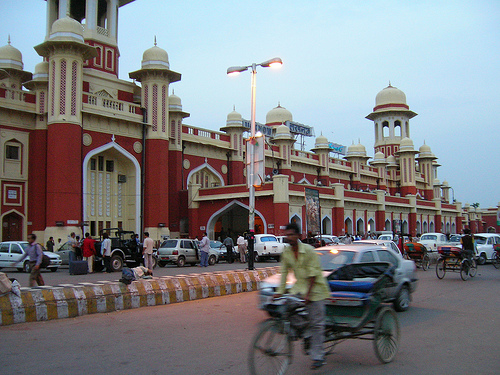
Location : Lucknow (Uttar Pradesh)
Designed by : J.H. Hornimen
Cost incurred : Rs. 70 lakhs
Foundation Laid In : 1914
Charbagh Station, the major railway station of Lucknow , is an architectural masterpiece. The ostentatious structural design of Charbagh Railway Station enthrals a tourist at the onset. Built at a whooping price of Rs. 70 lakhs, it was designed by J.H. Hornimen.
The foundation of the Charbagh Railway Station was place by the Bishop, in March 1914.
Qaiser Bagh Palace
Muhammed Ali was succeeded by his son, Wajid Ali Shah in 1837 who was also the last of the rulers to ascend the throne. A poet, singer and a great patron of arts, his pursuit of personal pleasure left little time for looking into administrative responsibilities. This led to the British annexation of Awadh. Wajid Ali Shah's single contribution to Lucknow was the Qaiser Bagh Palace built in 1850, which he wanted to be promoted as the eighth wonder of the world!
Juma Masjid
The Juma Masjid, with its two minarets and three domes is yet another delightful place to visit in Lucknow. An interesting building built by Muhammed Ali Shah is the Baradari, also known as the Picture Gallery, which houses the portraits of the erstwhile, Nawabs and Kings of Awadh.
Here one can admire the marvelous costumes and jewellery that the nobles a adorned themselves with. A patient of chronic rheumatism, Muhammad Ali died in 1842 and left behind a number of incomplete monuments, which would have honored him as the greatest builders amongst all Awadh Kings.
The Sat Khanda (or seven slices) was an edifice planned to resemble the minaret of Babylon with each of its storeys superimposed on the other -the top of which was to provide one of the finest views of Lucknow. Not far from the picture gallery is yet another marvel, the Clock Tower which is said to be the largest in India. This was however completed in seven years at the cost of more than a lakh of rupees- an enormous amount at the time!
Muhammad Ali's Imambara
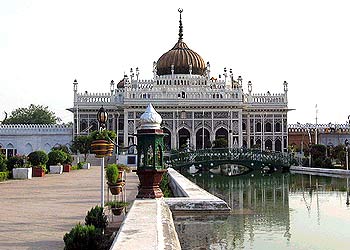
The British crowned the third king of Awadh, Muhammad Ali who was the second son of Nawab Wazir Sadat Ali, in 1837 at a ripe old age of 63. Muhammad Ali was just and popular ruler under whom Lucknow once again regained its splendor for a brief spell. Interested in building activities, he built his own Imambara as well as the Juma Masjid. The Imambara, left incomplete by Muhammad Ali, was later completed by Begum Mallika Jehan of the Royal family. Between the Imambara and the gateway is a large courtyard with a rectangular raised tank spanned by a bridge.
Within the Imambara is the burial place of the king while his daughter and son-in-law are buried on one side of the courtyard. The Imambara is noted for its golden dome, exquisite chandeliers, huge mirrors, silver mimbar, colourful interiors and delicate calligraphy on its arched entrance.
Tarunvali Kothi
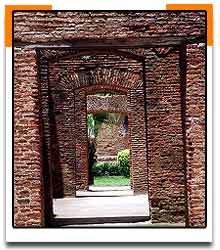
Ironically, the proclamation of kingship coincided with a period of almost complete dependence on the British. The title of King neither improved the administrative capabilities of the rulers nor their morale. The second King Nasir-ud-Din Haider, son and successor of Gazi-ud-Din, was so effeminate that he often spoke and dressed like a female. His only contribution in the field of architecture was the construction of Tarunvali Kothi, an archeological center, which was equipped with sophisticated instruments and entrusted to the care of a British astronomer.
British Residency
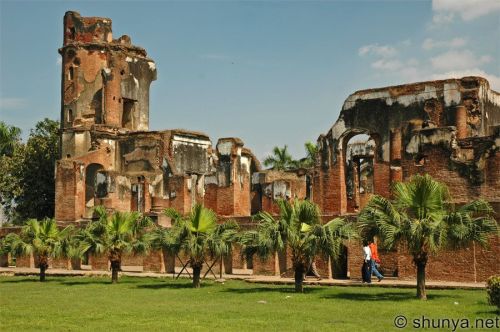
Unlike his predecessor, Sadat Ali proved to be a great builder who introduced a large number of architectural styles. One of his best-known monuments is the Residency, which was built in 1800 for the British Resident.
Today it stands desolate as a mute witness to the Mutiny of 1857 when it was almost completely destroyed. Despite its numerous scars, this monument retains till today its original charm that almost recreates the history associated with it and is a stark reminder of the numerous sieges during the Mutiny. Among the long list of grand palaces commissioned by Sadat Ali the Moti Mahal, Dilkusha Palace, Hayat Baksh, Chattar Manzil, Khusheed Manzil and Lal Baradari, deserves a visit.
The Nawab Wazirs of Lucknow, dissatisfied with their present titles, wanted to be called Kings, which at the time only the Emperors of Delhi were entitled to have. In 1819, Gazi-ud-Din, son and successor of Sadat Ali was made the fist king.
Gazi-ud-Din was a generous ruler, a good monarch who paid due attention to administration and justice. He was responsible for building and public works of all kinds. His buildings include the Mubarak Mahal, Shah Manzil and the Hazari Bagh, in which he introduced to the society of Lucknow, the sport of animal combats for the first time.
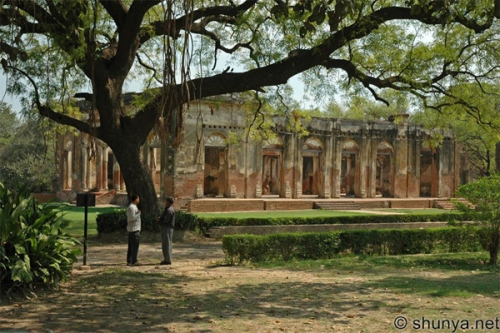
Lucknow Residency
Rumi Darwaza or The Turkish Gate
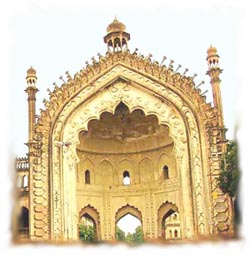
Towards the west of the Imambara is the Rumi Darwaza or the Turkish Gate built by Asaf-ud-Duala between the years 1784 to 1786. The 60 feet high gateway stands as an equally grand entrance to the great hall. During the Nawabi era, a huge lantern placed atop the Rumi Darwaza would light up the pathway, while jets of water gushed from the numerous fountains created on the rim of the gateway.
While on one hand the Nawabs had achieved a certain degree of independence from the Moghuls in Delhi, they surrendered their hold over the years as allies to the British who were there in the form of the East India Company based in Calcutta. Asaf-ud-Duala's son, Wazir Ali took over the throne after his father's death in 1798. After four months of misrule and bad behavior, the British removed Wajid Ali from the throne in 1798, who had by then acquired enough powers to manipulate the events of Awadh. Sadat Ali Khan, Asaf-ud-Daula's brother, was offered the throne, who during his 16 years of reign, earned himself a reputation of being an able administrator and the most sagacious Nawab that Lucknow had ever known.
Bara Imambara
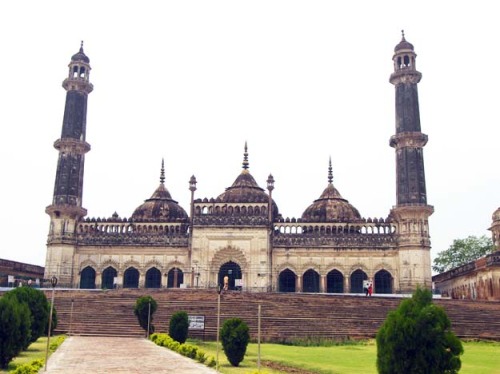
Asaf-ud-Daulah was also an inveterate builder of monuments. Driven with an ambition to discover the glory of the past and present and surpass them in magnificence and splendor, the numerous buildings built by Asaf-ud-Duala, like the Bara Imambara built in 1784, the testify to his architectural zeal.
This is indeed a monumental feat considering the fact that it once boasted the largest vaulted hall in the world, with a 50 feet high roof, spanning an area of 162 feet and a height 53 feet in the absence of a single beam! After all, as per the Nawab's directive, his architecture was to be original in conception with no influence of any existing structure or design.
The galleries and corridors within the great Imambara form a complicated and intricate labyrinth (bhool-bhuliya) through which at times it is difficult to find your way. Its terrace provides a fine view of the Lucknow city. During one of his visits to the site, the pleasing aroma of food being cooked in giant ovens attracted the Nawab. It is here when he discovered the Dum process of cooking, wherein the food is cooked slowly in its own steam, which lends a unique aroma and flavor to the food. Impressed with the process, he ordered the royal kitchen to practice the same method of cooking.
Kaiserbagh Baradari
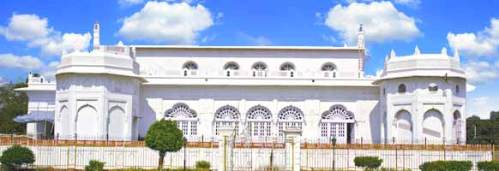
Baradari at Kaiserbagh
Lucknow on the Gomti river first attained prominence in the 15th century under the Sharqi sultans of Jaunpur. Later it was ruled by Mughal governors. By the 17th century it was a prosperous commercial centre, and continued to flourish from 1775-1856 as the capital of the independent Nawabs of Avadh (originally governors under the Mughals). The nawabs were great builders and patrons of the arts and attracted a variety of talent to their service which helped develop the city's culture. The Kaiserbagh complex was built by Nawab Wajid Ali Shah (ruled 1847-56), and was much damaged and looted in 1858. A baradari (literally twelve-doors) was an elegant nawabi-style pavilion, which together with gardens was an essential feature of much secular architecture in Lucknow. The Kaiserbagh Baradari, square in plan, stood in the middle of the palace complex, and contained a number of collonnaded halls of varying sizes.
--
Haider Ajaz
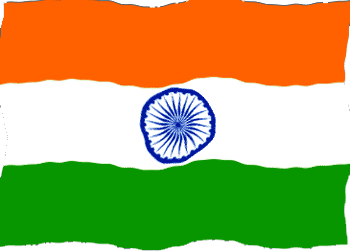


2 comments:
This is one of your best post...
Thanks for sharing valuable information....
For more info please visit: http://www.proptiger.com/residential-apartments-flats-lucknow.php
The article is good to read and worth sharing
spoken English classes in Baroda
Post a Comment